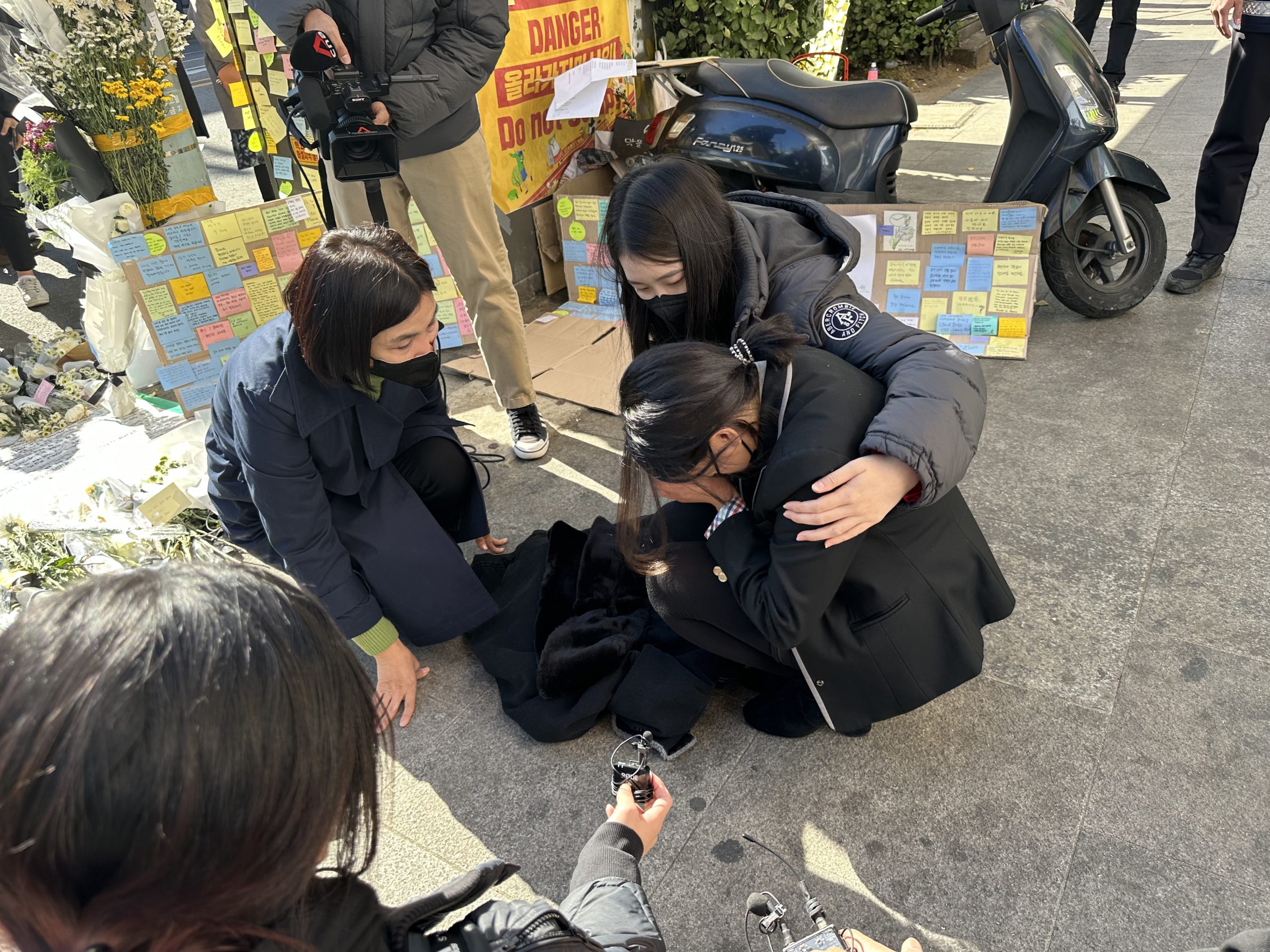
Na Kyung Heo, an intern at a Singaporean media company, consoles her interviewee, a student who lost three friends in Itaewon
Michelle Ye Hee Lee has sharp memories of her first traumatic assignment. It was 2011, and U.S. Rep. Gabby Giffords had been shot in a suburban Arizona supermarket parking lot, the victim of a gunman whose rampage that January morning would kill six people and injure 13.
Among the dead was nine-year-old Christina-Taylor Green. The AP reported that the girl’s parents were donating their daughter’s organs, and Lee’s Arizona newspaper editor asked the young reporter to contact the father and check the story.
“I remember listening to him cry as I had to confirm every single body part of his daughter and feeling, ‘Oh man, I know this is my job and I have to get through it,’” recalls Lee. “It was several years later that I wondered: What was I doing? Did we have to put him through that? Did we have to match the AP story and re-traumatize him? What are we putting aside in order to do that story? The moment still stays with me.”
I reached out to Lee after reading her coverage of another trauma — the deadly crush of young Halloween celebrants that killed 158 in Itaewon, a popular Seoul neighborhood. I had just arrived in South Korea to participate in a democracy forum as the country declared a period of national mourning. Coverage and discussion of the tragedy were inescapable, even in a week when North Korea menaced its neighbor by launching missiles into the East Sea.
A heavy burden of Itaewon coverage was the need to review the hundreds of police call logs and videos posted on social media channels, evidence of the horror people experienced as the crowd swelled. This was followed by video of the desperate, mostly futile efforts to revive the victims, many of them wearing the Halloween costumes that hours earlier had promised a night of celebration long delayed by the pandemic.
But beyond reporters’ reconstructions of the disaster and mournful accounts of the fatalities — a dozen of the dead were teenagers and more than 100 were in their 20s — I was struck by how open some journalists were about the emotional toll of covering the story.
The facade that reporters historically wore in recounting traumatic events had been replaced by a new public candor and questioning, unrecognizable from what Lee, now Tokyo/Seoul bureau chief for The Washington Post, experienced a decade ago post-shooting. As I followed the Itaewon story, I felt that I was witnessing an overdue generational shift in how we manage traumatic stories and the reporters who cover them.
“I had really great mentors in the [Arizona] newsroom, but there was no culture then of asking, ‘How are you doing? What do you need?’” Lee recalled when we spoke. “It’s only been in the last three to five years that this culture has shifted, and it’s okay for journalists to talk about being human … and not fear that that affects our credibility.”
Within days of the Itaewon disaster, there were social media announcements for “online grief and healing sessions” being offered to journalists in Seoul by the Asian American Journalists Association. Lee, the outgoing president of AAJA, helped launch similar sessions during the height of the Covid-19 pandemic “because the mental needs of our members [were] rising.”
Jeanie Chang, a U.S. certified clinical trauma specialist who was born in Korea, ran the sessions and said the challenges of covering the Itaewon story were compounded by the “vicarious trauma” journalists had already experienced during this epic year.
“I’m not saying that 2022 was more traumatic than ever, but Covid, a war, political and racial tension, school shootings — we were not meant to endure trauma after trauma,” she said.
In her off-the-record conversations with the journalists, Chang talked about managing the stress and grief that are common to such assignments. Some of her counsel is hard (sleep; it’s okay to also have fun) and some of it thoroughly practical (make the word document on your screen large and the video small; watch the video but turn the audio down; turn off TikTok).
She notes there has been progress in how newsrooms address the challenges of trauma reporting, but that the work needs to be ongoing, not episodic.
“If newsrooms don’t put mental health at the forefront,” she told me, “I don’t know how the news survives.”
For South Korean journalists, the Itaewon story revived memories of the 2014 Sewol ferry disaster, when a boat sank off the southwestern coast of South Korea and more than 300 passengers, most of them high school students, died. A number of newsrooms made public apologies for their coverage, which had been tainted by naive trust in government statements that turned out to be false.
Chong-ae Lee, a senior journalist for the Seoul Broadcasting System, recognized in the story an opportunity to improve trauma reporting in her country — both for journalists and the subjects of their coverage — and published guidelines that continue to steer her newsroom and others.
The advice is wise: “Disaster reporting guidelines must be adopted and training must take place ahead of time so journalists are prepared. Ethical issues related to trauma … can’t be learned while covering an incident.” It is also provocative: “If a lot of journalists approaching victims and families seem to do more harm than good, try to organize a pool system. Families’ emotional trauma is not something to compete over.”
She has been building on her guidelines and working with a national trauma center to create a clinic for journalists, a need dramatically underscored by the Itaewon story. “I hope we can really make our community understand the importance of our role, that we sacrifice to get the right information, and that sustaining journalists’ health is important for our society.”
On the day before I left Seoul, I visited the Itaewon neighborhood, its main street bursting with floral memorials, photos and letters to the dead, religious figures chanting, and protestors angered by the slow response from police on the night so many in the community perished.
On a crowded stretch of sidewalk, I saw a young television reporter crouching, interviewing an even younger woman, who had begun to weep. The reporter looked up at her cameraman as if for guidance. I could feel her struggle, as would any journalist who has ever interviewed a grieving survivor. She gave the cameraman another plaintive look, then silently handed him her microphone and put her arms around the woman. She would ask no more questions, and the two of them stayed like that, each leaning against the other, for several minutes.
As the reporter prepared to leave, I introduced myself and told her I was moved by her compassion. She seemed relieved. “I didn’t know what to do,” she said. We exchanged contact information and arranged to talk a few days later. Na Kyung Heo (“I like to be called Lizzie”) is 23 and was working the Itaewon story as an intern for a Singapore-based media company. The woman she was interviewing the afternoon we met was a high school student who had lost three friends in the disaster.
That interview was the most difficult in a week that had included reporting on a lost-and-found center for bereaved families, hospitals where bodies had been taken, and memorial sites where she tried to ask parents and grandparents about their loss. “They turned their backs to the camera so it was a picture of me trying to talk to them,” she said.
Heo said her journalism training has not included guidance on trauma reporting or mental health and that she’s been relying on instinct and conversations with senior reporters in her newsroom. She thinks about the high school student often and notes that when that story aired, “they left the part out with my arms around her.”
She adds: “I hope she wasn’t hurt by what I did.”


